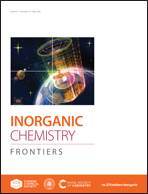Efficient doped and non-doped light-emitting diodes based on a TADF-emitting Cu4Br4 cluster†
Abstract
Copper-halide clusters emerge as a promising category of photoluminescent materials, attributed to their rich structural and photophysical properties in solid states. However, their environment-dependent emission quenching and challenges in film formation pose obstacles to their application in electroluminescent (EL) devices. Herein, we present Cu4Br4(AcNP)2, a sublimable copper-halide cluster chelated by a bidentate N^P ligand with a donor–acceptor configuration. The steric and electronic modification effects of the dimethylacridine group not only induce predominant (metal + halide)-to-ligand charge transfer and intra-ligand charge transfer characters in the excited states of the cluster, ensuring efficient and short-lived thermally activated delayed fluorescence, but also effectively prevent concentration quenching in films by avoiding intermolecular π–π stacking. As a consequence, 40 wt% doped and non-doped devices achieve maximum external quantum efficiencies of 12.8% and 10.2%, respectively. We anticipate that the current study offers insights into the design of copper-halide clusters for fabricating highly efficient EL devices, especially for non-doped EL devices.



 Please wait while we load your content...
Please wait while we load your content...